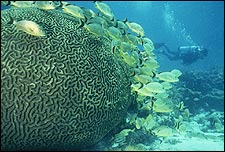 In the company of coral: a diver fins past a school of grunts off Florida’s Tavernier Key
In the company of coral: a diver fins past a school of grunts off Florida’s Tavernier Key Q: I’m a bloated son-of-a-gun with a physique like a manatee who’d like to try scuba diving. I have no experience at all outside of watching Sea Hunt and a couple of Jacques Cousteau specials when I was a kid. What’s a good place to go learn the basics?
— Michael Haltom, Lawrenceville, Georgia
���ϳԹ��� Advisor:
A: Hey, who says watching the amazing adventures of frogman Mike Nelson on the 1960s boob tube doesn’t count for experience? Sure, those high muckety-mucks at PADI might be able to teach you a thing or two about pressure groups and neutral buoyancy, but how will you know what to do when your newly acquainted diving buddy gets attacked by a giant squid or you stumble across a submerged thermonuclear warhead? From watching Sea Hunt of course!
Seriously now, living in the Southeast means you are in range of the world-class diving in the Florida Keys as well as the wealth of warm, freshwater springs that percolate throughout the Sunshine State. And you’ve got a couple of closer options for getting certified as an Open Water Diver, the entry level rung for scuba neophytes. There’s a shop right in Lawrenceville, Dive Dive Dive (; 678-407-2442) but you might also consider driving the 30 miles or so to Atlanta to take a Divers@Sea course (404-350-8510; ). These guys radiate that southern hospitality (at least to one anonymous caller) and offer packages that will get you on your way to new-found adventures. For a global listing of dive centers, dive resorts, and live-aboard dive boats, check out the World Wide Scuba Diving Directory ().
To get certified you’ll have about eight hours of classroom instruction, where you’ll learn about such things as nitrogen buildup in your blood, how long you can safely stay at certain depths, and other general dos and don’ts of the underwater world. You’ll then spend about eight more hours in a pool, where you’ll learn how to clear your mask of intruding water, control your buoyancy, and equalize the pressure in your ears, among other skills. Note that to get the certification you’ll have to demonstrate the ability to swim 200 yards without swim aids or 300 yards with mask, fins, and snorkel. Expect to pay about $225 for this portion of the course, including textbooks, videos, and equipment.
Diving Lessons Part Deux is when the real fun begins. Time to head out to actual dive sites, where you’ll need to complete at least four dives over two days with an instructor, demonstrating that you can perform in open water the skills you just learned in the pool.
This November Divers@Sea plans to run a trip down to Crystal River Springs north of Tampa, where the 72-degree waters from a natural spring bring excellent visibility. After you complete this portion of the course—it’ll set you back about another $320, including two nights in a hotel, three days of diving, equipment, but no food or travel—you’ll be a true recreational diver. Keep it up and the CIA might just call with a ticket to Peru asking if your services are for hire.


